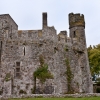Normandy – Landing Beaches and Castles
(2011)
Normandy (originally from the word for “northman” in several Scandinavian languages) is a geographical region of France corresponding to the former Duchy of Normandy. It is divided for administrative purposes into tworegions: Lower Normandy and Upper Normandy. The Channel Islands (referred to as Îles Anglo-Normandes in French) are historically part of Normandy, cover 194 km² and comprise two bailiwicks: Guernsey and Jersey, which are British Crown Dependencies.
The name of Normandy is derived from the settlement of the territory by Vikings (“Northmen”) from the 9th century, and confirmed by treaty in the 10th century. For a century and a half following the Norman Conquest of England in 1066, Normandy and England were linked by Norman and Frankish rulers.
During the Second World War, the D Day landings on the Normandy beaches under the code name Operation Neptune, started the lengthy Battle of Normandy which resulted in the Liberation of Paris, the restoration of the French Republic, and was a significant turning point in the war.
Zwischen 58 und 51 v. Chr. eroberte Iulius Cäsar die Region und nannte das Gebiet Lugdunensis secunda. 709 gründete der Bischof von Avranches dasKloster auf dem Mont-Saint-Michel. Im Jahre 841 wurde Rouen von den Normannen gebrandschatzt. Im Jahre 911 betraute Karl der Einfältige den Normannen Rollo mit dem Herzogtum.
Zu ihrem heutigen Namen kam die Normandie im Mittelalter als Heimstatt der Normannen, die sich als Volksstamm aus einheimischen „französischen“ Bewohnern und hinzugekommenen Wikingern gebildet hatten. Nach Ausweis der Sprach- und Ortsnamenforschung stammte die Mehrzahl der ansässig gewordenen Wikinger aus Dänemark, ein kleinerer Teil aus Norwegen.
Rollos Nachfahre Wilhelm, Herzog der Normandie, gelang 1066 die Eroberung Englands, was ihm den Beinamen „der Eroberer“ einbrachte. Er ließ sich dort zum König krönen. Die Normandie war bis 1087, von 1106 bis 1144 und von 1154 bis 1204 ein Teil Englands. Während des Hundertjährigen Krieges (1337–1453) war sie von 1346 bis 1360 und nochmal von 1415 bis 1450 von englischen Truppen besetzt – während des Zweiten Weltkrieges auch von der deutschen Wehrmacht. Die Küste der Basse Normandie diente den West-Alliierten als Landungszone für die lange geplante Invasion. Die folgende verlustreiche Schlacht begann am 6. Juni 1944 mit 6.400 Landungsfahrzeugen. Vor allem Caen litt sehr unter den Kämpfen, die bis zur Befreiung von Le Havre am 12. September andauerten.







































